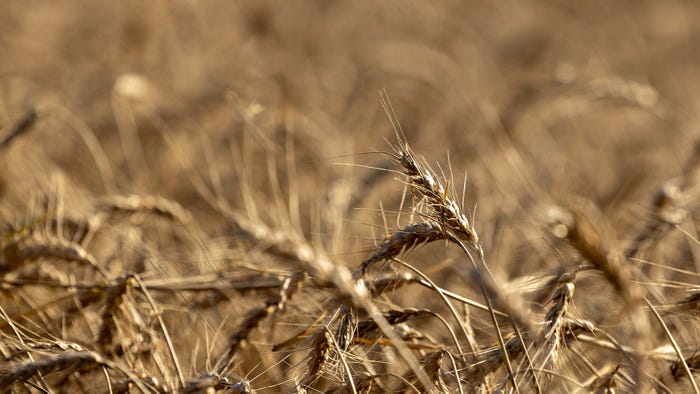
After months of drought throughout much of Oklahoma, it finally rained, delaying the conclusion of a rare year in wheat production. The last fields of the 2023 harvest are expected to be cut this week.
Initial predictions for this year’s yields were grim, and although some wheat fields were failed by insurance adjusters or baled for forage, producers were pleasantly surprised at the quality of the wheat they cut.
Southwest: Tillman County
“We ended up cutting exceptional yields,” said Landon Hunt, a producer in Grandfield. “Farmers in this area were astonished at where all the wheat came from.”

Many fields were failed out for insurance or baled for forage due to the drought. The remaining wheat rebounded after a cool and wet spring. (Photo by Mitchell Alcala, OSU Agriculture)
A hot and dry April had many producers in the area preparing to call insurance adjusters, but by the end of that month, the weather turned cool and wet, providing ideal conditions for wheat stalk heads to fill with grain.
“Our average wheat yield in this area has been anywhere from 45 to 70 bushels per acre, with really good test weights of 63 to 64 pounds,” Hunt said. “It’s been a phenomenal harvest, and the elevators are full.”
He said strong grain prices throughout 2023 motivated producers to manage their wheat closer this year.
“That extra fertilizer and effort on the part of farmers in this area went a long way in getting this crop across the finish line, and Mother Nature saved us in the nick of time,” he said.
Derek Jacobs, who farms near Frederick, also credits the wet spring weather for saving his crop.
“Yields were all over the board, but it was better than we thought,” he said. “We insured a few fields out, and we had some that made anywhere from 15 bushels to 50 bushels to the acre. The average was low 30s, but the test weight was just unbelievable at 62 to 64 pounds. I guess that goes back to the cooler and wetter May.”
Central: Kingfisher County
Matt Murray, whose production is located near Omega, said his average harvest yields were better than what he had expected at 35 bushels per acre. He usually finishes harvest by the end of June, but this year’s strange spring conditions meant Murray and his neighbors were still combining wheat well into July. A late harvest due to rain also led to problems controlling grass and weeds in his fields.
“We’ll never turn down a rain, but we went from drought to too wet,” he said. “Timely rains helped us out toward the end, I guess, but even the old timers say they’ve never seen anything like this.”
Northwest: Cimmaron County
Scott Arthaud in Boise City failed all his dryland wheat in early April when the crop showed no prospect of producing anything. Other producers in his county who waited to call an insurance adjuster got lucky when it began to rain weeks later. The wheat showed excellent filling, and other local producers baled the wheat for forage.
“Everything feels like it’s about two weeks late out here just because of the cooler temperatures, but the moisture has been great,” he said. “The rain we received in May and June was perfect for my irrigated wheat, which wasn’t as thin.”
The wet and cool spring improved his irrigated wheat that he plans to finish cutting this week, and he expects average yields. Although not all his fields measure the sub-moisture levels he’d like to see just yet, he said his part of the panhandle has turned a corner with drought.
“It’s been a tough two years, but the weather pattern has changed enough that we’re in excellent shape,” Arthaud said. “This is about as good as it gets here in Cimarron County. All the grass is green, and the irrigated yields will be good.”
Northeast: Nowata/Craig County
Wyatt Turney and his family, who reside near South Coffeyville, farm in both Oklahoma and across the state line into Labette County, Kansas. His area did not experience the extreme drought like other parts of the state and fared better, with average yields of 55 bushels per acre for hard red winter wheat and 63 bushels per acre for soft red winter wheat.
“We started June 9, and we were done by June 22,” Turney said. “We had timely rains but didn’t get a single drop of rain in the month of April. Our average test weight was right at 60 pounds, and moisture was 12.5% in almost every field.”
In May, the Oklahoma Wheat Commission reported that an estimated 2 million acres of wheat would be harvested across the state, totaling 40.7 million bushels. The 2023 crop is expected to be lower than the 47.6 million bushels of wheat Oklahoma harvested in 2014.
Watch Kim Anderson, Oklahoma State University Extension grain marketing specialist, analyze the latest crop market prices on SUNUP, OSU Extension’s production agriculture television show.
Also on SUNUP, watch Mike Schulte, executive director of the Oklahoma Wheat Commission, discuss the 2023 harvest and producers like the Williams family in Noble County navigate harvest in a rainy pattern.
Source: Oklahoma State University Extension
Read more about:
DroughtAbout the Author(s)
You May Also Like




